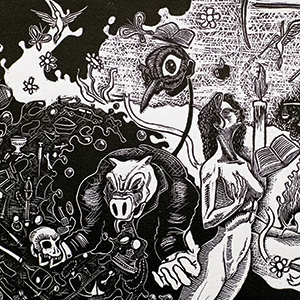

Anno Domini’s new group show, “The ASARO Collective,” brings together work from the Asamblea de Artistas Revolucionarios de Oaxaca, a revolutionary artist collective dedicated to creating social change through its creations.
The collective grew out of a response to the 2006 Oaxaca protests, a conflict between the Popular Assembly of Peoples of Oaxaca and the local government of the Mexican state. The protests resulted in the death of 17 non-violent demonstrators. In the fallout, the Mexican government was accused of violating human rights in its efforts to dampen the unrest.
The ASARO Collective is made up of artists from all walks of lifefrom trained painters to self-taught graffiti artists and students. It is a group born out of conflict, as can be plainly seen in much of the pieces now on display at Gallery AD.
The work in the show consists entirely of monochromatic handmade woodcut prints, portraying deeply symbolic scenes of violence, protest, and human rights struggles. The pieceswhich range in size from slightly larger than a square foot to four feet by five feeteach depict a different scene of pain and injustice. All of the woodcuts are a study in contrasts, cast in a line-heavy style that is at once chaotic and tightly organized.
No emotion was spared in the creation of this artwork. Steeped in historical imagery, the prints swarm with a dark energy. In some ways akin to the frenetic stillness of German Expressionismwhere each line is separated by empty spacethe art of The ASARO Collective takes great effort in capturing the pain of its subjects, which are often skeletons. A predominant feature of the work is the use of calaveras (“skeletons” in Spanish), most prominently known through bright Day of the Dead celebrations; except here the skeletons are cast in stark and brutal scenes, often centering on a protest or conflict with some type of authority.
Even the landscape scenesmostly centering on agriculture or livestockare imbued with a sense of loss and dread. Words plastered on protest signs, or on the front of tanks, like “autodefensas” or “obedece” give a sense of that desperation.
“ASARO is inspired by people who take action and assemble in political movements,” says collective member Jhovany Rodriguez. “We believe in the possibility of recovery of communities, by starting conversations with all sectors of society.”
Working in woodcuts, the ASARO Collective taps into the historic use of the medium for political art. Going back to Hans Holbein’s famous “Danse Macabre” prints and extending into the 1930s and ’40s with the New Woodcut Movement, woodcut prints have long served a role in the propagation of political ideasalso echoing Mexico’s long history with politically-concerned printmaking. ASARO continues this tradition with its darkly vibrant prints.
“We use the xylography (woodcuts) because the majority of artwork from ASARO was meant to be on the streets,” says Rodriguez. “This is a way that we can make multiple reproductions of our work.”
Born out of a teacher’s strike, the group pulls no punches in its exacting visual critiques of capitalism, workers rights violations and class conflict. This political manifesto is reinforced by the collectivist nature of the artwork; no piece is signed by one artist, and many are untitled, resulting in a cohesive and decidedly universal vision.
“We’re not looking for an exact political philosophy, we’re looking for the value of the message in every single art piece,” Rodriguez explains. “We always look for not only the rights for workers, but overall human rights.”
Though in some respects the work blends together in a sweeping, if not startling, portrayal of unrest and political conflict, each piece equally stands alone in transmitting a spectral sensation of death. The work captures pathos, pain, and above all perseverance in the face of oppression.
As a whole, the artwork in “The ASARO Collective” show finds beauty in conflict and small harmonies in transgression. The work acts as a ghostly reminder that beauty and art can exist nowhere but in the reciprocal to hardship and ugliness. Ultimately “The ASARO Collective” Show at Anno Domini is a sobering but inspiring reminder of the injustice that often is just out of reach.
The ASARO Collective
Thru Sep 23, Free
Anno Domini, San Jose
galleryad.com


